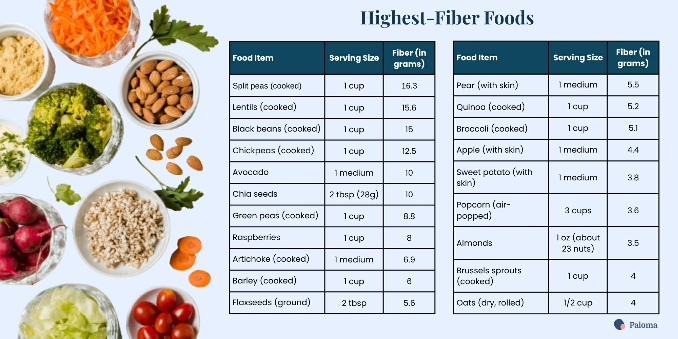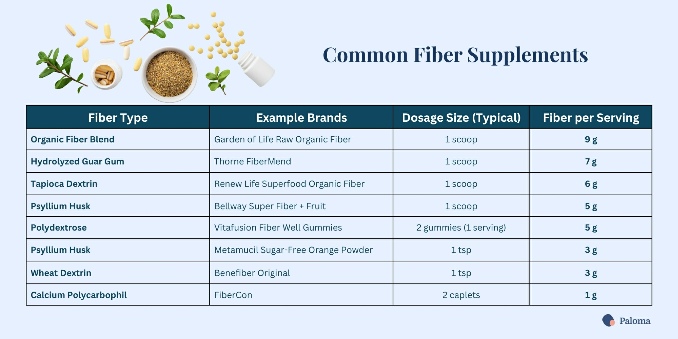In this article
Meet the experts
Kara Landau, RD, is an internationally recognized licensed dietitian with over two decades of experience as an expert in gut health, fiber intake, weight loss, and women’s health. She’s the founder of The Prebiotic Dietitian.
Lea Wetzell, MS, LN, CNS, is an award-winning integrative licensed nutritionist and certified nutritional specialist based in Minnesota. Lea helps menopausal women with prediabetes and type 2 diabetes gain control of their blood sugar through balanced nutrition.
Seyed Hassan Fakher, MD, is a physician with Invigor Medical, a U.S.-based telemedicine clinic specializing in weight loss, longevity, and sexual health.
Is fibermaxxing right for you?
Living with hypothyroidism can feel like a constant balancing act—managing symptoms, medication, and lifestyle choices to support your thyroid health. Recently, a new nutrition trend called fibermaxxing has taken social media by storm, promising a wealth of health benefits. But what exactly is fibermaxxing, and is it right for people with hypothyroidism? This article breaks down everything you need to know: what fibermaxxing is, its pros and cons, potential risks, and practical tips for those with thyroid conditions.
Fibermaxxing is the practice of intentionally maximizing your daily fiber intake by adding fiber-rich foods – and sometimes supplements – to every meal and snack to meet or slightly exceed the recommended amounts for optimal health. While it may seem like a trend, there’s solid science behind the fibermaxxing movement, given that most people consume far less fiber than they should.
For most adults, the recommended daily fiber intake is:
- Women: 25 grams per day
- Men: 38 grams per day (for men under 50); men over 50 should aim for about 30 grams per day
The bad news? According to the 2020–2025 Dietary Guidelines for Americans (DGA), more than 90% of women and 97% of men do not meet the recommended intakes for dietary fiber.
While nutrition experts suggest that fibermaxxing means aiming for the recommended amounts, we should note that some people are choosing to exceed them, claiming that even higher fiber intake has additional health benefits.
Fibermaxxing is all about increasing your daily fiber intake to support better digestion and overall health. The key idea is to make fiber-rich foods a highlight in your diet—think fruits, vegetables, whole grains, beans, lentils, nuts, and seeds. With some thoughtful meal planning, fibermaxxing recommends that you add fiber to every meal and snack throughout the day. Some people also choose to supplement their intake with fiber supplements, providing an extra boost to their fiber levels when needed. The approach is flexible and straightforward, making it easier to reach your daily fiber goals while enjoying a variety of tasty and satisfying foods.
Here’s fitness coach and influencer P.J. Morrison, giving his TikTok take on fibermaxxing:
Dietary fiber is an essential part of a healthy diet and comes in two primary forms: insoluble fiber and soluble fiber. Each type plays a unique role in maintaining digestive health and supporting other bodily functions. Some foods contain both types of fiber in varying amounts, making a varied diet key to reaping the full benefits.
Insoluble fiber
Insoluble fiber does not dissolve in water. Instead, it adds bulk to the stool and helps food move more quickly through the digestive system. This type of fiber is particularly helpful in preventing constipation and promoting regular bowel movements. It also supports overall colon health. Good sources of insoluble fiber include whole wheat products, brown rice, nuts, seeds, vegetables such as green beans, cauliflower, and potatoes (especially those with the skins), wheat bran, and leafy greens.
The following chart features some of the highest-fiber foods.

Soluble fiber
Soluble fiber dissolves in water to form a gel-like substance in the digestive tract. This type of fiber is especially beneficial for lowering LDL (“bad”) cholesterol and helping to regulate blood sugar levels by slowing the digestion and absorption of carbohydrates. Soluble fiber also supports a feeling of fullness, which can aid in weight management, and it serves as food for beneficial gut bacteria. Familiar sources include oats, barley, legumes (such as lentils, beans, and peas), apples, pears, citrus fruits, psyllium husk, carrots, and flaxseeds.
Resistant starch
A third category often associated with fiber is resistant starch, which acts like soluble fiber in the body. Although technically a type of starch, it resists digestion in the small intestine and ferments in the large intestine, producing short-chain fatty acids, such as butyrate, that promote gut health. Resistant starch is found in foods such as cooked and cooled potatoes, rice, and pasta, as well as green bananas, lentils, and certain whole grains.
Functional fibers
Finally, there are functional (or isolated) fibers, which are extracted or synthesized fibers added to foods or taken as supplements. These include ingredients such as inulin (derived from chicory root), methylcellulose, polydextrose, and wheat dextrin. While they can help boost overall fiber intake and may mimic some benefits of natural fibers, they don’t always provide the same health effects as fiber from whole foods.
Incorporating a mix of different types of fiber from a variety of whole foods is the most effective way to support digestive health, regulate cholesterol and blood sugar levels, and maintain overall well-being.
Fiber supplements (such as psyllium or inulin) can be a helpful addition to fiber intake when you have a hard time reaching fiber targets with food alone. The following chart shows the most common types of fiber supplements and the number of grams of fiber per serving.

Fiber is a crucial component of a healthy diet for everyone, but it’s particularly important when you’re hypothyroid. When you have an underactive thyroid, you often face a variety of metabolic challenges, including sluggish digestion, unintentional weight gain, elevated cholesterol levels, and increased blood sugar fluctuations. Incorporating more fiber into your diet can help you manage these symptoms and improve your overall well-being. Let’s look at fiber’s benefits for people with hypothyroidism.
Improved digestion and regularity
Constipation is a hallmark symptom of hypothyroidism, caused by a slowed metabolism that affects intestinal motility. Increasing dietary fiber—especially insoluble fiber from whole grains, vegetables, and seeds—can significantly improve bowel function by adding bulk and promoting regular, smoother movements. This not only brings digestive relief but also helps reduce bloating and discomfort that often accompany thyroid-related constipation, all of which can improve daily comfort and quality of life.
Weight management
Weight gain and difficulty losing weight are frequent issues for people with hypothyroidism, partly due to a reduced basal metabolic rate. High-fiber foods are not only low in calories but also take longer to chew and digest, promoting a longer-lasting feeling of fullness and reducing the urge to overeat. Additionally, fiber slows gastric emptying, helping regulate hunger hormones and keeping blood sugar more stable after meals, which can make weight management more achievable.
One 16-week intervention study found that increased dietary fiber intake was a consistent and strong predictor of weight loss, with participants losing an average of 7 pounds over the 16 weeks when following a high-fiber, plant-predominant eating plan.
Better cholesterol control and heart health
Hypothyroidism can increase LDL cholesterol (“bad cholesterol”) and contribute to insulin resistance, raising the risk for cardiovascular disease and type 2 diabetes. Soluble fiber, found in foods like oats, beans, and flaxseeds, binds with cholesterol in the digestive system and helps eliminate it from the body. This is particularly important because hypothyroidism can increase heart disease risk.
A 2019 meta-analysis published in The Lancet found that eating at least 25 to 29 grams of fiber per day reduces the risks of heart disease, stroke, type 2 diabetes, and colorectal cancer by 16 to 24%. Each additional 7 grams of fiber per day is associated with a 9% reduction in cardiovascular disease risk.
Better blood sugar levels
Increasing fiber intake can reduce fasting glucose and hemoglobin A1c levels, and also slows the absorption of sugar into the bloodstream, preventing rapid blood sugar spikes and crashes that can worsen fatigue and cravings.
Gut health and microbiome support
The gut microbiome plays a crucial role in immune function, hormone regulation, and even the conversion of thyroid hormones. Fiber acts as a prebiotic, providing fuel for the beneficial bacteria in your intestines. When these microbes break down fiber, they produce short-chain fatty acids (SCFAs) like butyrate, which help reduce inflammation and support gut lining integrity. These microbes even play a crucial role in hormone metabolism, including the conversion of inactive thyroid hormone (T4) into its active form (T3).
Supporting a diverse and balanced gut microbiome through fiber intake may indirectly enhance thyroid function and reduce systemic inflammation that can exacerbate autoimmune conditions like Hashimoto’s thyroiditis.
Potential protection against some cancers
Multiple studies suggest that a high intake of dietary fiber, particularly from whole plant foods, is associated with a lower risk of certain cancers, including colorectal cancer. This is partly due to fiber’s ability to support healthy digestion, regulate bowel function, and promote the elimination of carcinogens through the stool. While this isn’t specific to thyroid health, it’s a compelling additional reason to increase fiber intake as part of a holistic approach to long-term wellness.
While increasing dietary fiber offers many health benefits, there are significant caveats and potential risks, particularly for individuals with hypothyroidism. Understanding these downsides is crucial for making informed nutritional decisions and for optimizing thyroid health.
Interference with thyroid hormone medication absorption
The top concern for people with hypothyroidism is that research shows that a high-fiber diet can reduce the absorption of thyroid hormone replacement medication. Dr. Seyed Hassan Fakher explains. “A high fiber diet can reduce the absorption of thyroid medication like levothyroxine, potentially making it less effective for people with hypothyroidism who rely on this medication. When taking thyroid medication with a high-fiber diet, fiber binds to the drugs in the gut, decreasing their bioavailability. This interaction may result in less of the medication being absorbed into the bloodstream, leading to higher thyroid-stimulating hormone (TSH) levels and the need for increased medication doses to achieve the same effect. Clinical evidence indicates that patients consuming high-fiber diets or fiber supplements have been observed to require higher doses of levothyroxine to maintain normal thyroid function. When their fiber intake was reduced, their medication requirements decreased, indicating improved absorption.”
It’s clear that even if you’re taking your thyroid medication as prescribed, a significant increase in your fiber intake can reduce the effectiveness of your medication and result in an elevated TSH level and worsening hypothyroid symptoms.
Digestive discomfort and GI symptoms
A sudden or excessive increase in fiber—especially without adequate hydration—can cause a range of digestive side effects, including:
- Bloating, gas, and cramps - These symptoms are common, particularly when insoluble or highly fermentable fibers are consumed in large amounts.
- Constipation or even paradoxical worsening of constipation can occur if fiber is increased without enough water.
It’s also important to note that people with sensitive digestive systems, irritable bowel syndrome (IBS), or other gut disorders may find high-fiber diets especially challenging. Insoluble fiber can exacerbate bloating and discomfort in IBS, while fermentable fibers may cause excess gas and abdominal pain.
Potential for nutrient malabsorption
Very high fiber intake can interfere with the absorption of various nutrients. This is particularly significant for people with hypothyroidism. Certain nutrients—such as selenium, zinc, iron, and vitamin D—are essential for thyroid hormone synthesis and function. Hypothyroid patients may have higher requirements for these nutrients, making any reduction in absorption more clinically significant.
- Fiber-mineral binding: Dietary fiber, especially insoluble types and those high in phytates (such as wheat bran), can bind essential minerals, including iron, calcium, magnesium, and zinc, in the gastrointestinal tract. This binding limits their absorption, making these nutrients less available to the body.
- Physical entrapment: Fiber can physically entrap minerals, further reducing their bioavailability. The effect is more pronounced with certain types of fiber and when intake is well above recommended levels.
- Shortened transit time: Excessive fiber can speed up intestinal transit, reducing the time available for nutrient absorption.
The potential for malabsorption is increased because hypothyroidism slows down metabolism and gut motility, which already impairs the breakdown and absorption of nutrients. This means hypothyroid patients start at a disadvantage regarding nutrient extraction from food. Many with hypothyroidism also have reduced gastric acid secretion, which is necessary for the absorption of minerals like iron and zinc. High fiber can compound this problem by further inhibiting absorption.
Risk of overdoing it: Bowel obstruction
Consuming fiber well above the recommended daily intake can, in rare cases, lead to bowel obstruction or fecal impaction, particularly if not accompanied by sufficient fluid intake.
- Symptoms of excessive fiber: Severe bloating, abdominal pain, constipation, and in extreme cases, intestinal blockage.
- At-risk populations: Individuals with a history of bowel surgery, intestinal strictures, or motility disorders should be especially cautious.
- Proper balance: Most adults need about 25–35 grams of fiber per day. Regularly exceeding this amount—especially with supplements—can increase the risk of complications.
There’s no question that dietary fiber is an essential part of a healthy diet, and fibermaxxing can be a powerful tool for improving digestive health, weight management, and overall well-being. But experts suggest that hypothyroid patients approach fibermaxxing carefully.
Nutritionist Lea Wetzell, MS, LN, CNS, cautions patients with hypothyroidism against aggressive fibermaxxing. “Clinical evidence shows that high-fiber foods such as wheat bran, psyllium, and fiber supplements can bind to thyroid hormone in the gut, reducing its absorption and potentially increasing TSH levels.”
Kara Laundau, RD, of The Prebiotic Dietitian, agrees and cautions thyroid patients not to go all in on fibermaxxing. According to Landau: “For those diagnosed with hypothyroidism, it would be recommended not to follow the trending fibermaxxing advice, and rather consume meals or products rich in dietary fiber a few hours before, or after taking the medication, to prevent any interference the fiber may have with the medication’s absorption.”
Fibermaxxing is not a one-size-fits-all solution. The key is careful management and following guidelines that will help you harness the benefits of higher fiber intake while minimizing the risks.

Time your medication carefully
Take your thyroid medication on an empty stomach, at least 30–60 minutes before eating. Wait at least 4 hours after taking your medication before consuming high-fiber meals or fiber supplements. This can help minimize interaction.
Nutritionist Lea Wetzell also notes that hypothyroid patients taking levothyroxine should be aware that “newer formulations of levothyroxine—such as liquid or soft-gel capsules—appear to be less affected by dietary fiber, offering a helpful alternative for sensitive individuals.”
Research shows that liquid or soft-gel capsules, such as Tirosint-SOL and Tirosint capsules, are far less affected by fiber compared to tablets.
Monitor your symptoms
If you notice increased fatigue, weight gain, or other hypothyroid symptoms after increasing your fiber intake, talk to your healthcare provider. You may need to adjust your medication dose or timing.
Get your thyroid rechecked
If you have significantly increased – or decreased – your fiber intake, it’s essential to check your thyroid lab results to determine if you need a dosage adjustment.
Increase your fiber intake gradually
Gradually increase your fiber intake over several weeks. This gives your digestive system time to adjust and minimizes uncomfortable side effects, such as bloating and gas.
Nutritionist Lea Wetzell explains: “Aim to gradually add 5 to 10 grams of fiber and maintain a consistent daily intake. Any significant change in diet should be followed by thyroid testing within 8 weeks to assess whether your dose still fits your body’s needs.”

Stay well hydrated
Drink plenty of water—fiber needs fluid to move through your digestive tract. Aim for at least 8 cups (approximately 2 liters) a day, or more if you’re increasing your fiber intake.
Be strategic about the type of fiber
Kara Landau recommends that hypothyroid patients be strategic with the types of fiber consumed to maximize the benefits without overdoing it and having adverse complications. Says Landau: “This includes seeking dietary fiber that can play a dual role as a fiber and a prebiotic, ensuring you are nourishing your gut health while also supporting your digestive tract and satiety goals. Examples of fiber-rich foods that are also prebiotic include kiwi fruits, apples, roasted and cooled potatoes, whole-grains, as well as vegetables such as asparagus and onions.”
Watch for mineral deficiencies
If you’re eating a very high-fiber diet, make sure you’re getting enough iron, calcium, magnesium, and zinc. Your doctor may recommend blood tests to monitor your levels.
Watch for signs of overdoing it
Watch for persistent bloating, abdominal pain, constipation (especially when not accompanied by sufficient water intake), or signs of nutrient deficiencies. If you notice these, reduce your fiber intake and consult your doctor.
GI conditions? Consult your doctor first
For most people, increasing fiber intake is safe and beneficial, but it must be done thoughtfully. If you have a digestive condition like IBS, IBD, or SIBO, it’s essential to consult your doctor before making significant changes to your fiber intake.
Fibermaxxing—intentionally increasing your fiber intake—can offer real benefits for people with hypothyroidism, including better digestion, improved blood sugar balance, and weight support. But it’s crucial to approach fiber changes carefully, especially when you’re managing thyroid hormone replacement treatment for hypothyroidism. Paloma Health can help you take an innovative, personalized approach to fibermaxxing while optimizing your hypothyroid treatment. Your Paloma care team can guide you on how to safely and gradually increase your fiber intake, remind you to drink enough water (at least 8 cups a day), and ensure your thyroid medication is taken properly—on an empty stomach and away from fiber-rich meals or supplements that may interfere with its absorption.
Paloma Health also offers an easy, at-home thyroid testing kit to help you monitor your thyroid levels before and after making dietary changes. Since fiber can impact how your body absorbs thyroid hormone, regular lab testing is essential to avoid under- or overmedication. Paloma’s expert practitioners can help you interpret your results and adjust your treatment plan as needed. Whether you’re incorporating new fiber-rich foods or experimenting with fiber supplements, the Paloma team ensures your thyroid remains supported and stable every step of the way!
- Fibermaxxing refers to reaching – or exceeding – fiber intake of 25 grams per day for women and 35 grams per day for men.
- Fibermaxxxing can improve digestion, blood sugar, cholesterol, and weight, key concerns for people with hypothyroidism.
- High-fiber diets may interfere with the absorption of thyroid medication, potentially requiring dosage adjustments.
- Symptoms such as fatigue, weight gain, or elevated TSH levels after increasing fiber may indicate reduced medication effectiveness.
- Increase fiber slowly, drink at least 8 cups of water daily, and take thyroid meds on an empty stomach, at least 4 hours away from fiber.
- Consider liquid or softgel forms of levothyroxine, which may be less affected by dietary fiber.
- Work with a healthcare provider and test your thyroid levels regularly when increasing fiber intake to ensure your treatment remains effective.

.webp)



%20(1).webp)
%20(1).webp)
%20copy%202.webp)






